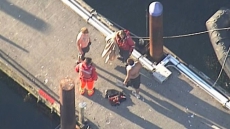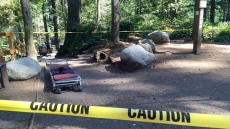MONTREAL — The foundations of an 18th-century village discovered on the future site of a major highway interchange in Montreal will not be preserved, provincial and municipal officials confirmed today, despite the calls of some local groups to save the site.
Montreal Mayor Denis Coderre, Quebec Transport Minister Robert Poeti and Culture Minister Helene David held a Sunday news conference to announce a working committee to study and preserve the 150 boxes of artifacts taken from the site, which was once the location of one of the province's first tanneries.
Archeologists unearthed the ruins of the former village earlier this summer. Known as "Tannery Village," it consisted of several homes and businesses linked to leather processing and the fur trade. Artifacts recovered from the site thus far include shoes and bits of leather, tools and other household items dating back to the late 18th century.
Benoit Dorais, mayor of the Sud-Ouest borough where the site is located, says that the village's origins go back a century earlier, making it one of the first settlements outside city walls and an important piece of Montreal's industrial heritage.
"It was the foundation of our neighbourhood, now called St-Henri, and over the decades and centuries that followed, it was the urbanization of Montreal that started there," he said.
Dorais is organizing a Monday night candlelight vigil to encourage the municipal and provincial governments to preserve certain parts of the site that he says won't directly affect the highway interchange project.
For now, the walls and foundations of the homes and businesses on the sight are expected to be removed once the site has been fully documented.
An open letter calling for the preservation of the site last week was signed by a number of local politicians, urbanists and heritage organizations.
The site lies in the path of the rebuilding of the Turcot interchange, an important transportation artery that serves 100 million people every year, according to Poeti.
He and the archeologists working for the Ministry of Transport pointed out that Montreal's harsh winters and the site's proximity to a major construction site make it difficult to keep.
"To leave the pieces of wall that remain exposed in open air won't stand the test of time," he said. "And it's hard to do a visiting site in the middle of Turcot."
Coderre pointed out that Montreal, like most cities, is built on top of what came before, and he would have to "move the city" if no building could ever take place on historic sites.
He said the project's archeological services budget was $1.6 million, and the city and province will invest more to ensure the artifacts recovered from the site are properly preserved, analyzed and showcased.
"Are we able to find a balance between protecting our heritage and sharing knowledge, all while creating this important development which is Turcot?" he asked.
"The answer is yes. We can assure you, we have the balance between the two."




